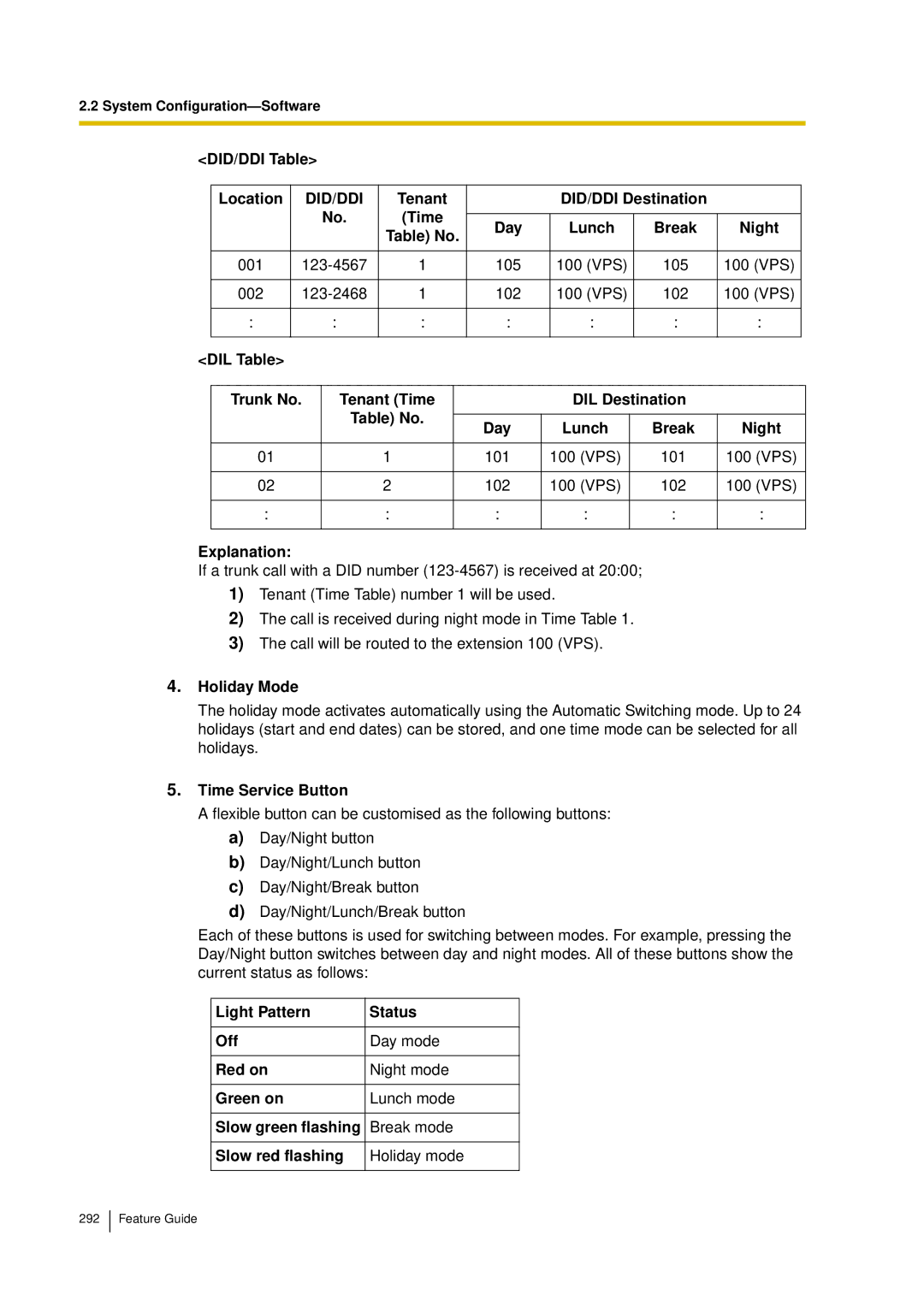
2.2System
<DID/DDI Table>
| Location |
| DID/DDI | Tenant |
|
| DID/DDI Destination |
|
| ||||
|
|
|
| No. | (Time |
|
|
|
|
|
|
| |
|
|
| Day |
| Lunch | Break | Night |
| |||||
|
|
|
|
| Table) No. |
|
| ||||||
|
|
|
|
|
|
|
|
|
|
|
| ||
|
|
|
|
|
|
|
|
|
|
|
|
| |
| 001 | 1 |
| 105 |
| 100 (VPS) | 105 | 100 (VPS) |
| ||||
|
|
|
|
|
|
|
|
|
|
|
|
| |
| 002 | 1 |
| 102 |
| 100 (VPS) | 102 | 100 (VPS) |
| ||||
|
|
|
|
|
|
|
|
|
|
|
|
|
|
| : |
| : | : |
| : |
| : |
| : | : |
| |
|
|
|
|
|
|
|
|
|
|
|
|
|
|
<DIL Table> |
|
|
|
|
|
|
|
|
|
|
|
| |
|
|
|
|
|
|
|
|
|
|
| |||
| Trunk No. |
| Tenant (Time |
|
|
| DIL Destination |
|
| ||||
|
|
|
| Table) No. |
|
|
|
|
|
|
|
| |
|
|
|
|
| Day |
| Lunch |
| Break | Night |
| ||
|
|
|
|
|
|
|
|
|
| ||||
|
|
|
|
|
|
|
|
|
|
|
|
| |
| 01 |
|
|
| 1 |
| 101 | 100 (VPS) |
| 101 | 100 (VPS) |
| |
|
|
|
|
|
|
|
|
|
|
|
|
| |
| 02 |
|
|
| 2 |
| 102 | 100 (VPS) |
| 102 | 100 (VPS) |
| |
|
|
|
|
|
|
|
|
|
|
|
|
| |
| : |
|
|
| : |
| : | : |
| : | : |
| |
|
|
|
|
|
|
|
|
|
|
|
|
|
|
Explanation:
If a trunk call with a DID number
1)Tenant (Time Table) number 1 will be used.
2)The call is received during night mode in Time Table 1.
3)The call will be routed to the extension 100 (VPS).
4.Holiday Mode
The holiday mode activates automatically using the Automatic Switching mode. Up to 24 holidays (start and end dates) can be stored, and one time mode can be selected for all holidays.
5.Time Service Button
A flexible button can be customised as the following buttons:
a)Day/Night button
b)Day/Night/Lunch button
c)Day/Night/Break button
d)Day/Night/Lunch/Break button
Each of these buttons is used for switching between modes. For example, pressing the Day/Night button switches between day and night modes. All of these buttons show the current status as follows:
Light Pattern | Status |
|
|
Off | Day mode |
|
|
Red on | Night mode |
|
|
Green on | Lunch mode |
|
|
Slow green flashing | Break mode |
|
|
Slow red flashing | Holiday mode |
|
|
